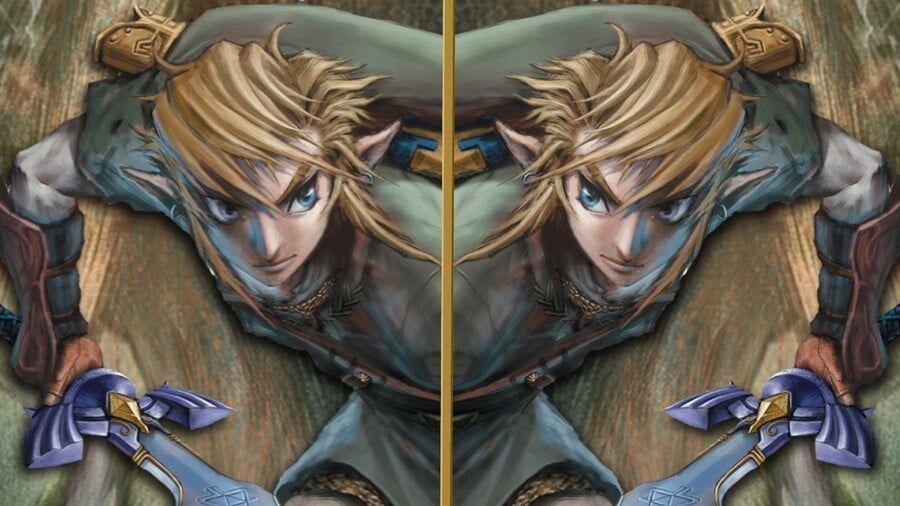
To celebrate the 35th anniversary of The Legend of Zelda, we’re running a series of features looking at a specific aspect — a theme, character, mechanic, location, memory or something else entirely — from each of the mainline Zelda games. Today, Gavin regrets the fact that he let a tiny, insignificant detail spoil his time with a wonderful and strange game…
There’s so much I could talk about when it comes to The Legend of Zelda: Twilight Princess. I could go on about its strange cast of characters — oddball vendors, shadowy twilight figures, Yetis — or delve into its themes of duality and otherness. I could dissect the collection of cats, dogs and wolves it features (verbally dissect, of course), or wax lyrical over the majesty of its Hyrule Field theme. I could happily crack out a thousand words on the impish Midna and her role as — surprise! — a non-annoying sidekick, or examine its muted art style; the realisation of the grittier, more ‘realistic’ Zelda many fans had wanted Wind Waker to be.
Plenty of retrospective fodder, then. However, to this day my overriding memory of the first Zelda game to launch on two consoles near-simulateously is how the Wii version flipped the entire kingdom of Hyrule on its Y-axis and I spent my entire playthrough worrying about it. It gnawed at me as I entered each new area and tried to imagine what the ‘real’ version of the game was — the one which better fit my notions of Hyrule’s canonically established geography. Yeah, but the other way round my mind would repeat over and over, and I simply couldn’t shake it. Whenever I grabbed my Wiimote and Nunchuk and fired up this brand new Zelda adventure, the thought was there, lingering like a winter fart in a new car.
It’s really quite silly when you think about it. The topography of Link’s homeland changes in practically every game, and while you’ll occasionally see familiar locations at familiar compass points, there’s absolutely no reason to expect that Death Mountain and the Gorons will always be found in the North East or that you’ll always find Lake Hylia in the South West. Breath of the Wild plonks the Lost Woods right next to Death Mountain — it’s no biggy. Hyrule is a place where legend and location are fluid concepts, free to be reinterpreted, reconfigured and retold in different ways.
Still, with the overworld map from Ocarina of Time‘s manual imprinted on my brain thanks to it being my first ever Zelda game (hey, I was a Mega Drive kid), seeing all those places in Twilight Princess in approximately the same locations but flipped gave me both that thrilling buzz of recognition and a sense of confusion and disappointment that things weren’t in the right place.
It always struck me as exceptionally strange that Nintendo felt the need to ‘flip’ the world just so Link would be right-handed, anyway, especially given the fact that it makes no difference whatsoever to the way the game controls. Waggle the Wiimote and Link swipes his sword around more or less as if you’d pressed a button. I honestly don’t recall paying attention to the hand that swung the sword; it was vitally important to somebody, presumably. I can only imagine that they had aspirations of Skyward Sword-style 1:1 motion that simply wasn’t possible until MotionPlus came along, but by the time the devs discovered it was impossible, it was too late to walk the world-flip back.
Why didn’t you play the canonical and superior GameCube version, then? I hear you ask in an all-knowing gamer voice. Well, that’s easy to say now, isn’t it? But you have to remember that at the time I’d just got a shiny new Wii (it was genuinely the shiniest console I’d ever seen to that point), and naturally I wanted the ‘best’ experience going. Waggle aside, the Wii version supported 16:9 widescreen and looked a bit sharper, so of course I wanted that one. If you’ve got the choice between a PS4 game or the PS5-upgraded version, you need to be strong-willed to turn down the next gen perks, no?

Looking back, I obviously made the wrong choice. Not only did the GameCube version have the ‘canonical’ layout (whatever that means in a series that until recently let you name your hero whatever you the hell you wanted), but it also featured free camera control thanks to the second stick that the Wii Remote lacked. I never got around to playing the Wii U version either, which flipped things back to the GameCube layout.
Rationally, I know it wasn’t a big deal, but I still feel a pang of regret and shame at allowing my stupid Lizalfo brain to constantly distract me from soaking in every detail and enjoying a fine and fascinating game. I had fun, sure, but I also ruined it for myself because I couldn’t shake the sense that Kakariko Village was on the ‘wrong’ side.
With any luck, I’ll be able to experience it ‘fresh’ sometime in the future, perhaps on a console I’ve already got hooked up to the telly. That’d be nice.
